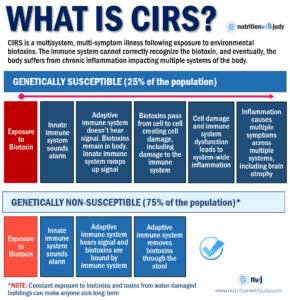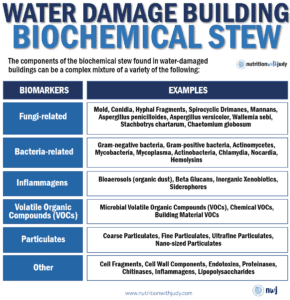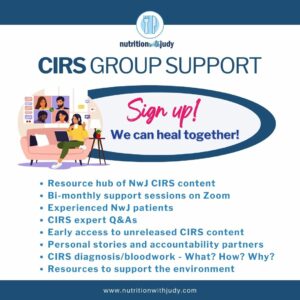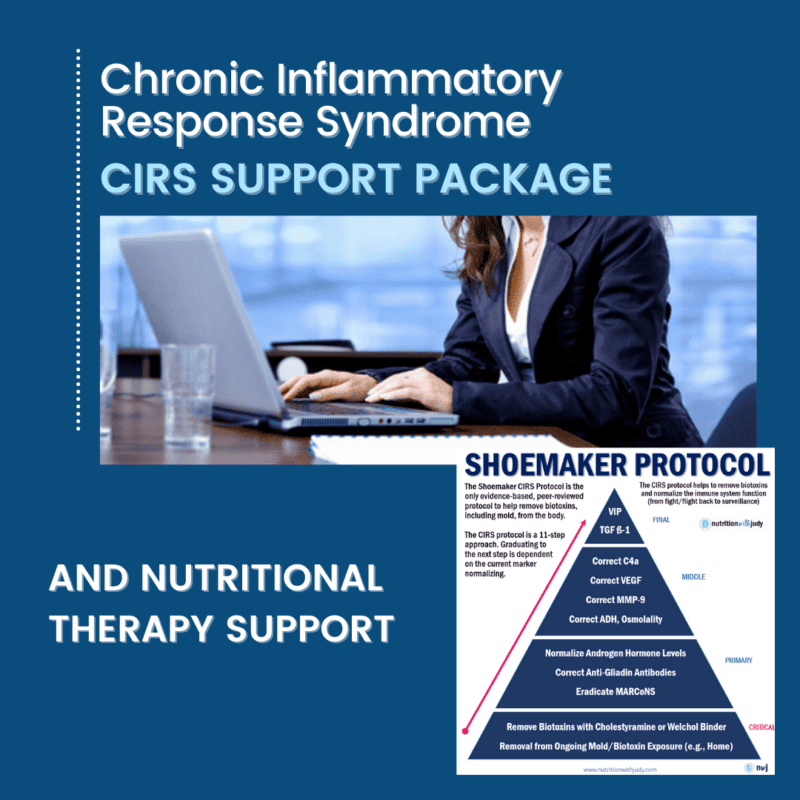

CIRS and GENIE Testing


Chronic Inflammatory Response Syndrome (CIRS) is a complex illness triggered by biotoxins such as mold and Lyme disease. Managing CIRS can be challenging due to its varied symptoms, but GENIE (Genomic Expression: Inflammation Explained) testing offers a promising solution for troubleshooting treatment roadblocks. Developed by Dr. Ritchie Shoemaker, this advanced genomic test analyzes gene expression patterns related to inflammation and immune response, providing precise insights into CIRS.
While GENIE testing is not used for diagnosing CIRS, it is often used for refining treatment when patients encounter obstacles in their recovery. It can also be ordered at the beginning of treatment to help create a more personalized plan, provided finances allow. By offering a detailed analysis of gene expression, GENIE testing aids practitioners in tailoring treatments to the individual’s unique genetic profile.
Let’s take a closer look into the specifics of GENIE testing, its benefits, and its role in the Shoemaker Protocol, providing a comprehensive exploration of how this unique tool can enhance the management of CIRS.
What Is CIRS?
Chronic Inflammatory Response Syndrome (CIRS) is a complex condition with a variety of symptoms that impact multiple bodily systems. This syndrome is caused by widespread inflammation due to an overactive immune response. Recognized as a legitimate medical condition, diagnosing CIRS requires comprehensive lab tests and a detailed review of the patient’s medical history.
The diverse symptoms of CIRS often lead to misdiagnosis or insufficient treatment. Unlike other immune disorders that show abnormal adaptive immune responses, CIRS cannot be identified through standard autoimmune blood tests.


What triggers the heightened immune response and widespread inflammation associated with CIRS? The culprit is biotoxins—biologically derived toxic substances. These biotoxins can initiate and exacerbate CIRS, originating from various sources, including:
- Water-Damaged Environments: Approximately 80% of CIRS cases are linked to exposure to air in water-damaged settings. These environments harbor mold mycotoxins, bacteria, and chemical irritants that provoke inflammatory reactions in susceptible individuals. Both living and non-living mold components significantly contribute to inflammation in the body and brain.
- Insect Bites: Certain insect bites, such as those from ticks and spiders, can lead to long-term conditions such as chronic Lyme disease. Pathogens such as Borrelia burgdorferi and Babesia microti are commonly involved, and venom from recluse spider bites can cause prolonged health issues.
- Seafood Consumption: Eating tropical reef fish contaminated with ciguatera toxin, often linked to harmful algae blooms like cyanobacteria (blue-green algae), can trigger biotoxin-related illnesses. This toxin accumulates in larger reef fish that eat smaller fish, which have ingested dinoflagellates.
- Contact with Contaminated Water: Exposure to or inhalation of water contaminated with toxic algae blooms, including Pfiesteria and cyanobacteria, can also trigger the inflammatory responses characteristic of CIRS.
- Other Biotoxin Sources: Additional triggers for CIRS include exposure to certain vaccines, viruses, volatile organic compounds (VOCs), endotoxins, and actinomycetes. These elements can all contribute to the development of the syndrome.


Biotoxins are tiny molecules that can penetrate cell membranes, making them difficult to detect with standard blood tests. These toxins typically enter the body through inhalation but can also be introduced via ingestion, tick and spider bites, and direct contact with contaminated water.
Not everyone exposed to common biotoxins like mold will develop CIRS. Susceptibility to biotoxin-related conditions is significantly influenced by genetic factors and life stressors. Severe illnesses, surgeries, high fevers, pregnancies, substantial biotoxin exposure, and other traumatic incidents can trigger a cytokine storm. This may activate the CIRS gene in genetically susceptible individuals, particularly those with HLA-DR genes, indicating that CIRS can manifest at any stage of life. It’s important to understand that a lack of symptoms does not equate to immunity, and genetic testing can offer valuable insights for prevention.
While biotoxins might cause immediate illness, most people’s immune systems can identify and eliminate these toxins effectively. However, individuals genetically predisposed to CIRS have immune systems that fail to recognize and clear these toxins, allowing them to persist in the body. This results in a chronic, severe immune reaction and extensive inflammation, leading to a variety of symptoms and long-term health issues.
For a more detailed understanding of CIRS, click here.
Pro-Tip: If you think you’re suffering from CIRS, start with our White Glove Service for comprehensive care.
What Is the GENIE Test?


The GENIE (Genomic Expression: Inflammation Explained) test is a cutting-edge diagnostic tool developed by Dr. Ritchie Shoemaker to aid in the management of CIRS. Unlike traditional tests, the GENIE test analyzes gene expression patterns to uncover specific genomic changes associated with inflammation and immune response.
GENIE isn’t a single nucleotide polymorphism (SNP) test. It looks at actual differential gene activation with values compared to controls in testing done in Bedford, MA. This advanced analysis provides a detailed picture of how an individual’s genes are behaving in response to biotoxin exposure, offering insights that standard blood tests cannot.
Within the Shoemaker Protocol, the GENIE test serves a crucial role in troubleshooting treatment roadblocks and optimizing patient care. While it is not used for the initial diagnosis of CIRS, it can be a helpful tool when patients encounter obstacles in their recovery. The GENIE test can also be ordered at the beginning of treatment if financial resources allow, providing a personalized treatment plan based on the patient’s unique genomic profile. By identifying specific gene expression anomalies, Shoemaker practitioners can tailor interventions more precisely, improving the effectiveness of treatments and enhancing patient outcomes.
We generally only recommend ordering a GENIE if you’re at a roadblock in treatment but this varies from case to case. Always work with your trusted CIRS practitioner to decide if GENIE is a worthwhile investment for your care.
How Does a GENIE Test Work?
Here is a detailed overview of how GENIE testing works:
1. Sample Collection: The process begins with collecting a blood sample from the patient. This sample contains RNA, the genetic material needed for analysis.
2. RNA Extraction:In the laboratory, RNA is extracted from the blood cells. RNA, unlike DNA, reflects the active gene expression in cells, providing a snapshot of which genes are turned on or off in response to biotoxin exposure.
3. Gene Expression Profiling: The extracted RNA undergoes reverse transcription to create complementary DNA (cDNA). This cDNA is then analyzed using advanced genomic technologies such as microarrays or next-generation sequencing (NGS).
These technologies measure the expression levels of thousands of genes simultaneously, identifying which genes are upregulated (more active) or downregulated (less active) compared to normal levels.
4. Transcription and mRNA: Gene SNPs (single nucleotide polymorphisms) are part of our DNA coding, residing within the cell nucleus. DNA is surrounded by a fluid environment that influences gene expression. DNA information is transcribed into messenger RNA (mRNA), which carries genetic instructions to ribosomes where proteins are synthesized. mRNA plays a crucial role in how genes express themselves. The expression of mRNA during transcription can indicate how our bodies are functioning and responding to environmental factors.
5. Protein Synthesis and Ribosome Function: Proteins are synthesized in ribosomes, cellular structures that read mRNA and assemble amino acids into proteins. These proteins are essential for repairing and replicating parts of our body to maintain homeostasis.
GENIE testing provides insights into the messages sent out by mRNA and how well ribosomes are functioning. This information helps to understand the body’s response to inflammation and biotoxins.
6. Data Analysis: The raw data from the gene expression profiling are processed and analyzed using bioinformatics tools. These tools compare the patient’s gene expression profile with established patterns associated with CIRS and other inflammatory conditions.
Specific algorithms and statistical methods identify significant deviations from normal gene expression patterns, highlighting genes involved in the inflammatory and immune response.
7. Interpretation and Reporting: The results are compiled into a comprehensive report that outlines the key findings of the gene expression analysis. This report provides detailed insights into the patient’s inflammatory status and the specific genetic pathways affected. The report is interpreted by healthcare providers trained in the Shoemaker Protocol. They use this information to identify potential treatment targets and tailor interventions to the patient’s unique genetic profile.
8. Clinical Application: The insights gained from GENIE testing can help refine and adjust treatment plans. For example, if certain inflammatory pathways are overactive, specific anti-inflammatory therapies can be prescribed. Additionally, the test can monitor the effectiveness of treatment over time, allowing for real-time adjustments based on the patient’s evolving gene expression profile.
What Are the Benefits of GENIE Testing?
Although GENIE testing is not used for the initial diagnosis of CIRS, it can be helpful for identifying specific genetic factors that may be hindering recovery when patients encounter obstacles. By examining the expression of genes involved in inflammation, practitioners can pinpoint the underlying issues causing treatment resistance.
GENIE testing provides a comprehensive view of a patient’s unique genetic expression profile. This information allows practitioners to tailor treatments specifically to the individual’s needs, enhancing the effectiveness of therapeutic interventions. Personalized treatment plans can lead to more precise and effective management of CIRS symptoms.
The dynamic nature of gene expression means that GENIE testing can be used to monitor how a patient’s genetic activity changes over time. This real-time data enables healthcare providers to make informed adjustments to treatment plans, ensuring that interventions remain effective and responsive to the patient’s evolving condition.
For patients who can afford it, ordering GENIE testing at the beginning of treatment can provide a baseline of gene expression. Early insights into a patient’s genetic profile allow for the anticipation and mitigation of potential complications, leading to more proactive and preventative care strategies.
Targeted interventions based on the detailed genetic insights provided by GENIE testing can result in more effective and timely relief of symptoms. By addressing the specific pathways involved in inflammation and immune response, patients are more likely to experience significant improvements in their overall health and well-being.
GENIE testing looks deep into the genetic mechanisms driving inflammation. This detailed analysis helps practitioners understand which specific inflammatory pathways are overactive or dysfunctional, guiding the selection of appropriate anti-inflammatory therapies and other targeted treatments.
Chronic conditions such as CIRS require ongoing management. GENIE testing offers a roadmap for long-term care by providing insights into how the patient’s body responds to various treatments over time. This allows for the continuous optimization of therapeutic strategies, improving long-term health outcomes.
The comprehensive nature of GENIE testing, which looks at a wide range of gene expressions, offers a holistic view of a patient’s health. This broad perspective can reveal connections between various symptoms and underlying genetic factors, promoting a more integrated approach to treatment.
Understanding one’s genetic predispositions can be empowering for patients. GENIE testing provides valuable information that patients can use to make informed decisions about their health, lifestyle, and treatment options, fostering a collaborative approach to care.
What Are the Drawbacks of GENIE Testing?
While GENIE testing can offer valuable insights into gene expression patterns, it is important to understand its limitations and drawbacks. One significant limitation is that GENIE results are not always definitive. For example, certain genes may be turned on, indicating potential issues, but this does not conclusively mean the patient is experiencing those specific problems. Similarly, a patient might have conditions such as PTSD without the gene activation showing up as positive in the results. This variability can complicate the interpretation and application of the test outcomes.
Another major drawback is the cost associated with GENIE testing. The advanced genomic technologies used are expensive, making the test financially inaccessible for some patients. GENIE testing is not covered by insurance, adding to the financial burden. This high cost can prevent many from benefiting from the personalized treatment plans that GENIE testing may facilitate.
The complexity of interpreting GENIE test results is another significant challenge. The extensive data generated requires specialized knowledge for accurate analysis. Practitioners must be well-versed in genomic medicine and CIRS-specific pathways to effectively utilize the information. Misinterpretation can lead to ineffective or inappropriate treatment strategies, potentially worsening the patient’s condition. Always work with your trusted Shoemaker CIRS practitioner to interpret results.
Additionally, GENIE testing is not used for the initial diagnosis of CIRS but rather for refining treatment plans when patients face recovery obstacles. Therefore, it must be integrated with other diagnostic methods and clinical evaluations to provide a comprehensive understanding of the patient’s condition. Relying solely on GENIE testing without considering other diagnostic tools can result in an incomplete assessment.
The dynamic nature of gene expression further complicates GENIE testing. Gene expression can be influenced by various factors such as environmental exposures, lifestyle changes, and stress, making the results a snapshot in time rather than a comprehensive overview. This variability may necessitate repeated testing to monitor changes over time, increasing both cost and complexity.
Lastly, the evolving nature of genomic medicine means that our understanding of gene expression and its health implications is continuously growing. New research can change the interpretations and applications of GENIE testing, making it challenging for healthcare providers to stay current with the latest findings.
In summary, while GENIE testing offers significant benefits for managing CIRS, it also has notable limitations. Many of our CIRS patients and clients heal without having to invest in a GENIE but this can be a great tool in certain cases.
How Do You Order a GENIE Test?
A CIRS provider has to order the GENIE for you. They will send you vials to get blood drawn. You will have to ship the blood test with dry ice. Your provider should have specific tests performed before doing a GENIE as well. Ideally, GENIE should be used later on if you’re struggling with the Shoemaker Protocol.
How Do You Interpret Your GENIE Results?
The results include summary pages to help you understand the results. If you order a GENIE, there is a 30-minute consultation with Dr. Shoemaker included. Make sure to take advantage of this with your CIRS practitioner if you have any specific questions. It is essential to work with a trusted Shoemaker-certified CIRS practitioner to interpret your results.
For a detailed overview of GENIE test result interpretations, join our CIRS Support Group for the remainder of this content.
Closing Thoughts On GENIE Testing and CIRS
GENIE testing represents a significant advancement in understanding and managing CIRS. By analyzing gene expression patterns, GENIE provides detailed insights into the body’s inflammatory and immune responses, helping to identify specific genetic factors that might hinder recovery. This can be particularly beneficial for patients encountering roadblocks during the Shoemaker Protocol, allowing for more personalized and effective treatment plans.
However, it’s important to acknowledge the drawbacks and limitations of GENIE testing. The high cost and complexity of interpreting the results can make it inaccessible for some patients. Moreover, the results are not always definitive; gene activation does not necessarily indicate an existing issue, and some conditions might not show up in the gene expression analysis. Additionally, GENIE testing does not replace the need for other diagnostic tools and clinical evaluations, and repeated testing may be required due to the dynamic nature of gene expression.
Given these factors, GENIE testing is not a necessary tool for all cases of CIRS. Its use should be carefully considered, particularly in terms of cost and the specific needs of the patient. Working with the right practitioner is crucial in deciding if GENIE testing is valuable for your treatment. A knowledgeable CIRS practitioner can help determine whether this advanced testing will provide meaningful benefits in your journey toward recovery.


Pro-Tip: Are you looking for practitioner resources and a like-minded community to support you through your CIRS journey? Join our exclusive CIRS Support Group for the latest research, step-by-step protocol tools, and support to successfully achieve root-cause healing.
Work With Our Trusted CIRS Practitioners
The Nutrition with Judy practice is honored to be trusted CIRS practitioners having served hundreds of clients and patients from around the globe. We’re passionate about helping our clients achieve root-cause healing in order to lead the best quality of life possible that’s nearly symptom-free. Our team is dedicated to helping CIRS patients navigate this complex illness. If you’re interested in working one-on-one with our CIRS nutritional therapy team to support you through your journey, our CIRS Support Package delivers the support and accountability for achieving root-cause healing.
Start your root-cause healing journey today and contact us any time with any questions or concerns.
DISCLAIMER: This content is for educational purposes only. While we are board-certified in holistic nutrition and are nutritional therapy practitioners, we are not providing medical advice. Whenever you start a new diet or protocol, always consult with your trusted practitioner first.




